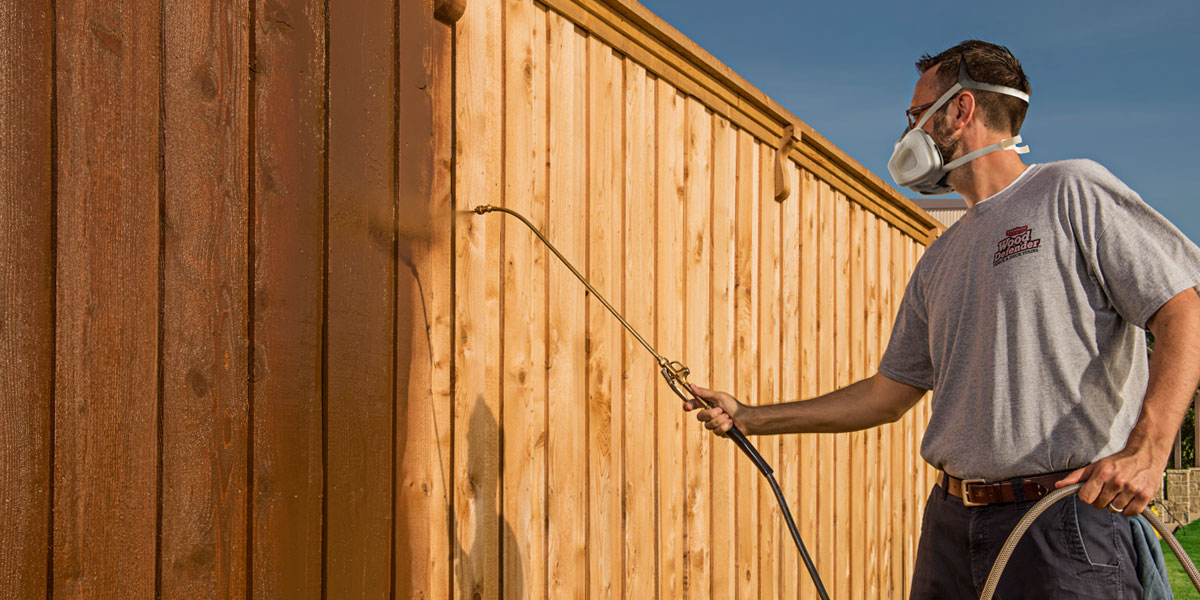Raise Your Outdoor Area with Specialist Fence Staining Services!
Raise Your Outdoor Area with Specialist Fence Staining Services!
Blog Article
How to Pick the Right Fence Discoloration for Your Property
When it comes to enhancing the appearance and longevity of your home's fence, choosing the best tarnish is a crucial choice that calls for cautious consideration. Just how can you ensure that you select the perfect fencing stain that straightens with your property's design and upkeep demands?
Comprehending Wood Types
To choose the proper fence discolor, it is necessary to have a thorough understanding of the different kinds of wood frequently made use of for fencing. The selection of timber plays a crucial role in determining the long life and total aesthetic appeals of the fencing. Cedar is a preferred choice as a result of its all-natural resistance to degeneration and pests, making it a resilient option for outdoor frameworks. Pine is an additional usual timber used in secure fencing, recognized for its affordability and simplicity of staining. Nevertheless, pine is a lot more prone to bending and decaying compared to cedar. Redwood is a premium choice known for its striking look and natural durability, though it comes with a higher cost tag. When picking a fence discolor, it is necessary to think about the kind of wood being utilized to ensure compatibility and ideal defense. Comprehending the qualities of different wood types will help you make an educated decision when it involves picking the right fence tarnish for your building - Fence Staining Nashville TN.
Picking the Right Color
Picking an ideal shade for your fence stain is an essential decision that significantly influences the general visual allure of your property. Lighter colors such as whites or light grays can make a fencing show up bigger and include a touch of beauty to your building. Ultimately, the ideal color choice will certainly enhance the charm of your fencing and elevate the general aesthetic charm of your home.

Taking Into Consideration Openness Levels
When picking the ideal shade for your fencing tarnish, another essential element to consider is the degree of transparency that will ideal suit your home's aesthetic and upkeep requirements. Openness degrees in fence stains usually fall right into three categories: clear, semi-transparent, and solid. Think about the degree of direct exposure your fence deals with, the wanted maintenance frequency, and the aesthetic you want to attain when selecting the best transparency degree for your fencing tarnish.
Evaluating Maintenance Demands
Taking into consideration the long life and upkeep of your fencing, examining the maintenance requirements is important in establishing the most suitable fence discolor for your property. The level of upkeep required for your fencing can differ depending on aspects such as the sort of timber, weather in your location, and your individual preferences.
When examining upkeep demands, it is vital to take into consideration the durability of the fencing discolor. Some spots need even more constant reapplication than others, so choosing a discolor with a much longer life-span can aid decrease the general maintenance needs of your fencing (Fence Staining Service). In addition, aspects such as resistance to UV rays, water, and mold can affect exactly how commonly you require to re-stain your fencing

Testing Samples Before Application
Before using any type of fence stain, it is suggested to perform sample examinations to ensure compatibility with the timber and desired aesthetic end result (Fence Staining Nashville TN). Examining samples allows you to analyze just how the tarnish will certainly interact with the particular type of wood used in your fence, as various timbers can soak up discolorations in a different way. To begin, pick a tiny low-profile area of the fence to apply the stain examples. It is advised to check several stain options on this area to contrast shades and coatings. Take into consideration just how the tarnish looks when completely dry, as it might show up different from its wet application. Additionally, observe just how the stain complements the existing components in your exterior space, such as landscaping or the color of your home. Keep in mind of exactly how the tarnish holds up to weather like sunlight and moisture. By examining examples prior to complete application, you can make an enlightened decision that enhances the total look of your residential property while safeguarding the wood efficiently.
Final Thought
In verdict, picking the appropriate fencing stain for my latest blog post your property involves understanding the timber type, selecting the appropriate color, considering openness levels, reviewing maintenance needs, and testing examples before application (Fence Staining Service). By taking these elements right into consideration, you can make sure that your fence tarnish matches your residential or commercial property while providing the required protection and sturdiness. Make an informed choice to boost the look and durability of your fencing
Report this page